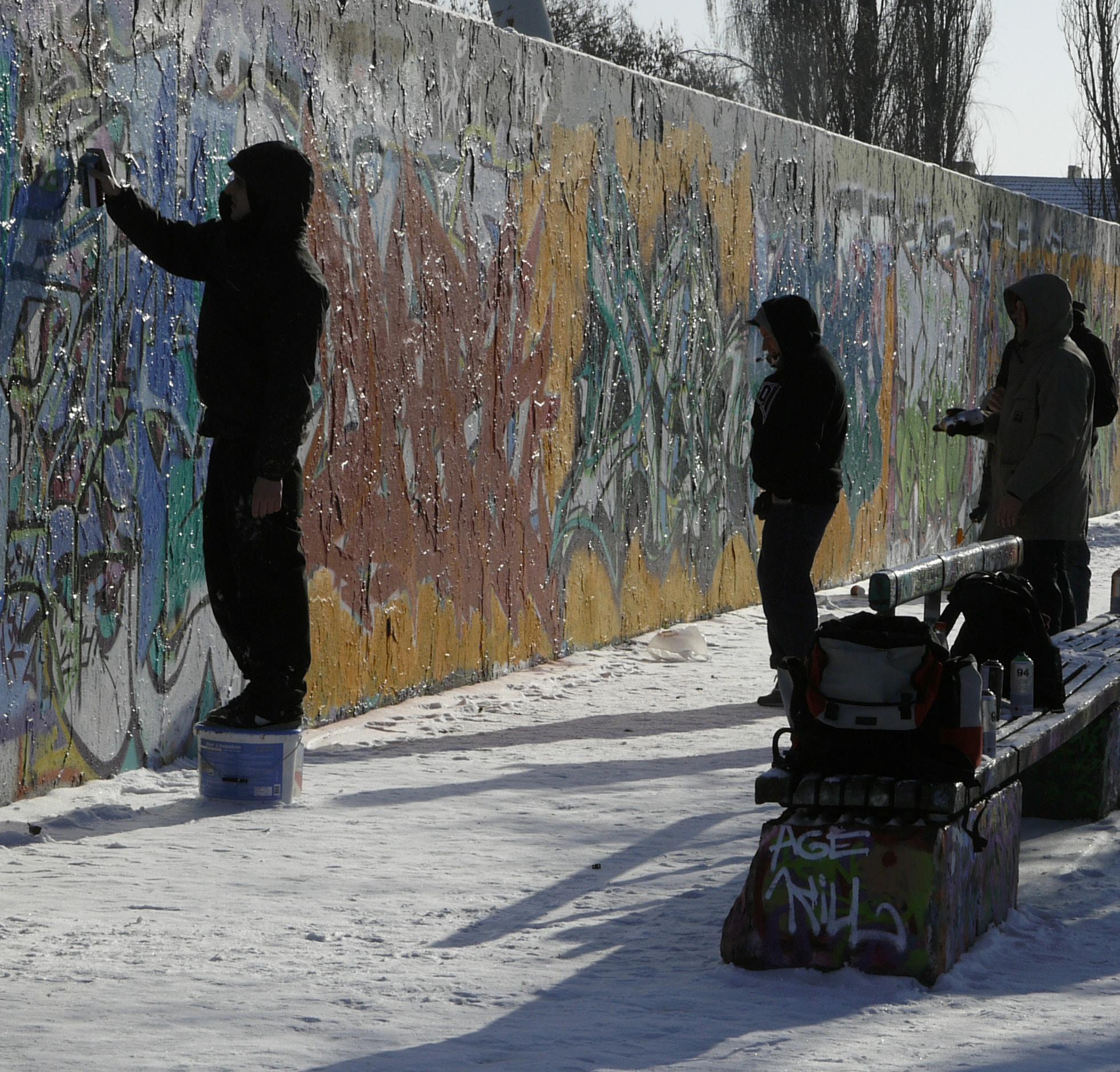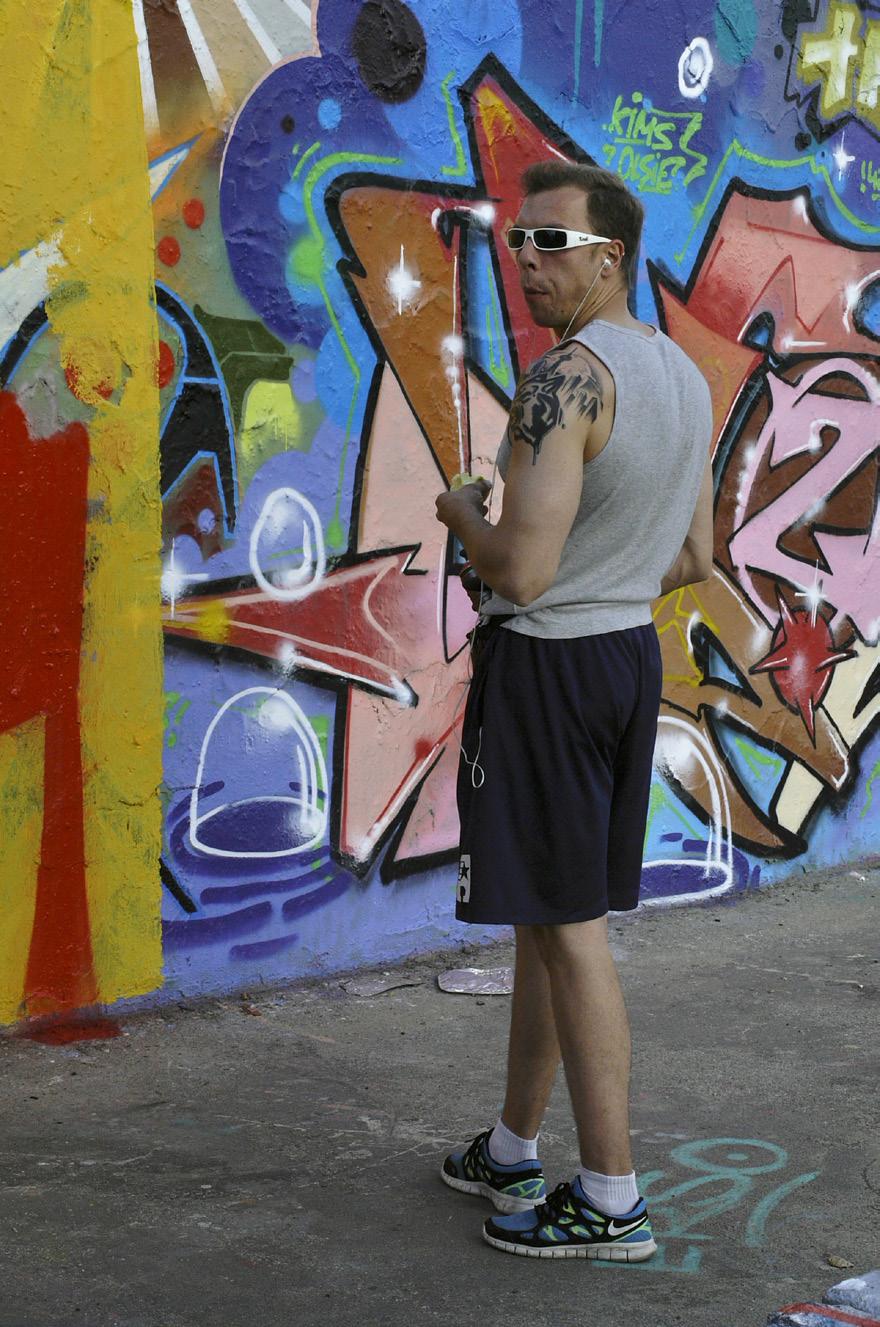
11 minute read
THE MAKERS OF STREET ART
Personal Encounters by Siegfried Rubbert LRPS

It was in June 2003 in Berlin when my fascination for the subject of street art began. I had a little time for a photo tour, and because our hotel was almost opposite, I visited the East-Side Gallery near the Ostbahnhof in Berlin Friedrichshain.
Since that time and another visit to Barcelona, discovering it’s street art, my fascination with this subject and finding street art in cities’ urbanity did not diminish.
No, it even grew, so today, I can look back on some over 5000 photographs on this subject.
From this large complex of themes, I would like to focus in this article on the subject of

The East Side Gallery is a permanent open-air gallery on the most extended remaining section of the Berlin Wall.
It was initially painted by 118 artists along a length of 1316 metres but is now no longer wholly preserved.
In 1991, it was listed as a historical monument, and in the years 2000 and 2008, it was refurbished again and again.


In 2003, when I was strolling beside the East Side Gallery and looking for motifs, I discovered a small gap in the at that time still completely preserved section of the Wall.
I climbed through and saw some sprayers doing their work on the back of the East Side Gallery facing the Spree in bright sunshine
I was so fascinated that I spent more time on that side, capturing more of the motifs applied to the Wall there, and eventually approached one of the actors about what he was doing.
It took a bit of persuasion before he allowed me to take a photo of him at work. I promised to take a picture of him only from the back and not to give him away.
So I only allowed myself one shot with my then beloved analogue Leica R 6.2..

Another encounter with the street art-makers took place in August 2008.
It happened in my hometown when the interest group of Hagen retailers had huge plywood panels put up in front of some of their shops and invited several street artists from the area to work on these walls.


As a fitting answer to the question of what fascinates me so much about street art, I would like to quote from the book - Street Art - Legends of the Street by the authors Katrin Klitzke and Christian Schmidt:
"Art that touches must cause something that the viewer has never experienced before.
By Encountering Art in a place where we did not expect it.
Street art, more than any other art form, contains the potential to create this special surprise effect.”


And further:
"Street art represents an unexpected surprise through Art rather than an unexpected surprise with Art.
Once we have experienced this fascination, we can always go out on the street and look for it.
Once the passion has taken hold of us, we use every path that we go to experience it again.
The unexpected can only be found where things are constantly changing."
So I am attracted to backyards, abandoned building sites or industrial wastelands, dark subways, abandoned narrow alleys, barren areas, and other urban environments.
That's what I find exciting.
Seeking the unexpected, I am perhaps a 21st-century flâneur - with the camera.
I have repeatedly encountered various artists on these paths, even very prominent ones, and have been allowed to photograph them at their public work after asking.


Many street artists work primarily at night and on the edge of legality or even entirely illegally.
Artists I was allowed to photograph always worked during the day and always on walls and buildings that their respective owners cleared.
The works were then publicly auctioned on the evening of the same day, and I was happy to bid for one of the pieces.



Subsequently, before visiting almost every city I could, I researched where in which area Street Art could be found and set out to find it.
Another iconic encounter with a former lesser-known but more and more ascending street artist took place in London on 4 January 2012.
Again, I researched and read a report in an architectural magazine about London's creative East End, illustrated with some London street art scene photos.
Consequently, the streets of Shoreditch were my next destination, and by sheer coincidence, at the beginning of my tour, I came across a large green gate not yet wholly painted.
In front of it was a sketchbook. The artist was not on site.


I recognised the gate from the magazine article, which was already depicted there, utilising two figures. However, the colour was different, now green instead of sky blue as in the newspaper clipping, and the arrangement of the two models was also other.
The artist was probably in the process of completely reworking the gate and creating a different design.
When he suddenly appeared in his gate’s vicinity, I approached him and asked him if he was Stik because his name was under the newspaper article’s corresponding picture. In the affirmative, he asked me how I knew his name, which country I came from, was highly pleased when I showed him the magazine article and invited me for a coffee in a small neighbouring coffee shop.
We talked for an hour, during which I got to know Stik as a highly likeable, cosmopolitan person.
At the end of the conversation, I asked him if I could take a photo of him, and shortly before saying goodbye, Stik knelt on the pavement to sketch a small Stik on a blown maple leaf.
Unfortunately, while my wife was leafing through our travel documents, this leaf fell out of its cover unnoticed and was blown away by the wind coming up in draughty London.
Regrettably, my wife walked back again and sadly did not find this precious souvenir of this unforeseen, unplanned and sympathetic encounter.
The newspaper article
4. January 2012 30. September 2012


On another trip to Great Britain, we read in the London's events calendar that the cultural historian Ingrid Beazley, who worked at the Dulwich Gallery, had invited Stik to design seven house walls made available to him on the occasion of the Dulwich Festival Week.

To do this, Stik sketched the old masters exhibited in the Dulwich Gallery, paintings by Thomas Gainsborough, Marcantonio Franceschini, Pieter Coecke van Aelst or Bartolomé Estéban Murillo and skilfully translated these paintings into his street art.


With his six-line, two dot figures, he is able to transform any person with his attitudes, postures and even feelings. In my eyes, he is a master at reading people.

In the months that followed, art historian Ingrid Beazley wrote a 351-page coffee table book covering the street art projects of two consecutive Dulwich Festival Weeks.
Ingrid used the above photo, which is based on the painting "The Fall of Man" from 1520-1530, and the portrait photo at the bottom left of the previous page, for her book "Street Art Fine Art" published in 2014 by Heni Publishing, London (ISBN 978-0-95640-419-0).




The following is written in this book about his biography:
"Stik is one of London's best known and most loved street artists.
He is renowned for painting simple androgynous stick figures; although simple, it conveys complex body language and emotion.
Themes of human vulnerability are infused into Stik's work, reflecting both the human spirit and his own life story and homelessness experiences.
Initially, Stik developed his simple style by having to execute works illegally.
He painted his characteristic figures on London streets in this manner for years and was instrumental in raising the British public's appreciation of street art.
Now, routinely invited to paint legally, Stik maintains his minimal simplicity for aesthetic reasons."
Meanwhile, Stik's works are auctioned at Christie's, and Stik donates the proceeds of many pieces to social causes such as the NHS.
A previous auction in 2015 raised £50,000 for the Homerton University Hospital.


Stik was not the only celebrity street artist I encountered on the streets of London's East End. Other internationally known artists I could watch at work were, for example, AKA Jimmy C (left picture) or Jim Vision (right picture).
In Berlin, I encountered the street art of AKA Jimmy C once again in the Revaler Strasse area and the passageway of Rosenthaler Strasse 39, at the end of which is the Anna Frank Zentrum.
Along with London, Berlin is also a hotspot of the street art scene, where I met many other actors of this art form.
One legal opportunity to work as a street artist in Berlin is the Mauerpark, a park on the former death strip's ruins between Prenzlauer Berg and Wedding's former districts.
It is an Eldorado for lesser-known or completely unknown beginners to realise or practise this Art.










THE COLLECTION IS GROWING
In addition to the fascination with photographing street art, not least due to the encounters with the various street artists, collecting smaller or larger street art objects has also become a passion.
For example, the collection is growing through a donation when I met the famous Berlin-based Thierry Noir on the occasion of one of his exhibitions.




Finally, I can only encourage you to see a street artist at work, dare, approach them. I have always found these artists to be very friendly, sometimes even very polite contemporaries.
Take pleasure in a sudden encounter with something unexpected, with Art as a form of expression of a primarily young generation.
Take pleasure in their compositions, their figures, called characters in the language of the sprayers, a piece, masterpiece, rooftop, paste-up, stencil, poster, sticker, leftover, mural or even the entire façade of a house, to name the variety of forms of expression of street art.
The artists work far away from museums, but mostly in cities' urbanity, to help shape, change, and beautify them.
Their Art mostly takes place in public spaces and hidden places, inhospitable places or abandoned, destroyed industrial wastelands, in so-called lost areas.

And yes, they live in an area of tension between illegal activity, even criminality on the one hand.
On the other hand, they are contemporary artists with contemporary forms of expression.
And perhaps for this very reason, suitable areas or walls should be released for this purpose so that the street artists are freed from illegality. Yes, and perhaps it is also the thrill of the photographer to be in this world, move in spheres that are not legally open, climb over a fence, visit closed-off buildings, find the gap, visit these abandoned, dark places.
And then you might be surprised, and maybe you too will suddenly say:
“OH WOW LOOK IT’S SOME STREET ART”


